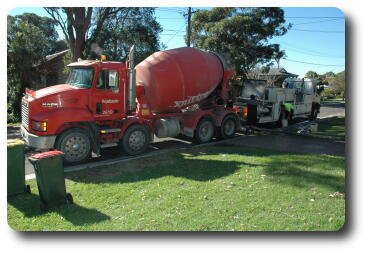 Then the distant rumble of a large diesel truck was heard, and
sure enough, it was the first load of concrete. One benefit of
living in a quiet area is that such noises are much easier to detect.
Here the truck has backed up to the concrete pumper.
Then the distant rumble of a large diesel truck was heard, and
sure enough, it was the first load of concrete. One benefit of
living in a quiet area is that such noises are much easier to detect.
Here the truck has backed up to the concrete pumper.
 Then the distant rumble of a large diesel truck was heard, and
sure enough, it was the first load of concrete. One benefit of
living in a quiet area is that such noises are much easier to detect.
Here the truck has backed up to the concrete pumper.
Then the distant rumble of a large diesel truck was heard, and
sure enough, it was the first load of concrete. One benefit of
living in a quiet area is that such noises are much easier to detect.
Here the truck has backed up to the concrete pumper.
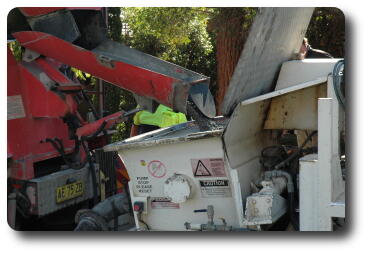 The truck driver added some water and ran the mixing action to
stir up his load while the pumper crew finished their preparations.
Then the truck backed a little closer into this position, and
a slow pouring of concrete started. This was to fill the hopper
to allow slow pumping of the concrete up the pipe, allowing one
of the crew to track the progress (by tapping the pipe) to warn
the distributors of progress and get them ready to start pouring.
The truck driver added some water and ran the mixing action to
stir up his load while the pumper crew finished their preparations.
Then the truck backed a little closer into this position, and
a slow pouring of concrete started. This was to fill the hopper
to allow slow pumping of the concrete up the pipe, allowing one
of the crew to track the progress (by tapping the pipe) to warn
the distributors of progress and get them ready to start pouring.
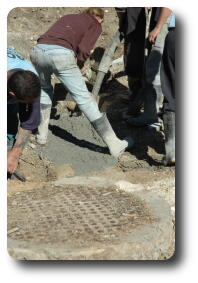
|
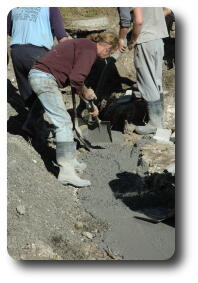
|
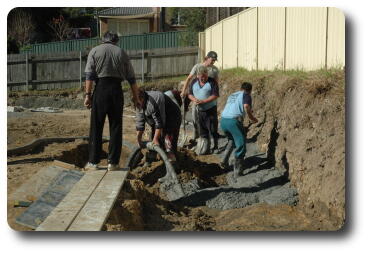 Working along the back fence. Note that there is no formwork. This
is not a precision operation, as it is really to form a base for
walls, and will be underground when everything is finished. Basically
in areas like this, the hoser aims for areas needing to be filled
and/or levelled, in this case under directions from Chris (builder,
with back to camera). The rest of the crew is spreading out the
base for the retaining wall at the back of the lot.
Working along the back fence. Note that there is no formwork. This
is not a precision operation, as it is really to form a base for
walls, and will be underground when everything is finished. Basically
in areas like this, the hoser aims for areas needing to be filled
and/or levelled, in this case under directions from Chris (builder,
with back to camera). The rest of the crew is spreading out the
base for the retaining wall at the back of the lot.
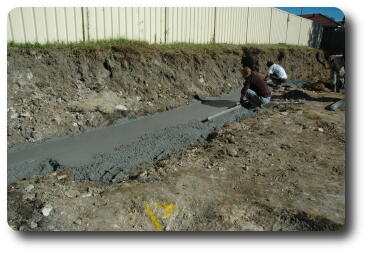 The smoothing crew at work. This strip will have a reinforced concrete
block wall built on it, so having a smoother finish makes it easier
for the block layers.
The smoothing crew at work. This strip will have a reinforced concrete
block wall built on it, so having a smoother finish makes it easier
for the block layers.
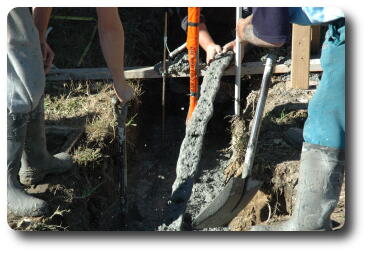 Filling the trench around the front of the garage on the northern side.
This is just under the switchboard, as you might have guessed from
the orange conduit wrapped in orange tape.
Filling the trench around the front of the garage on the northern side.
This is just under the switchboard, as you might have guessed from
the orange conduit wrapped in orange tape.
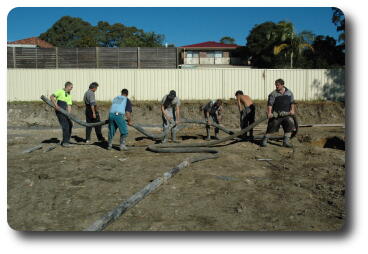 The concrete crew moves the hose from the eastern side to the western
side to pour the trenches around the family/dining/kitchen/porch area.
As you can imagine, the hose is heavy, being full of
wet concrete, and does not bend easily, as it is quite thick
to stand the pressure.
The concrete crew moves the hose from the eastern side to the western
side to pour the trenches around the family/dining/kitchen/porch area.
As you can imagine, the hose is heavy, being full of
wet concrete, and does not bend easily, as it is quite thick
to stand the pressure.
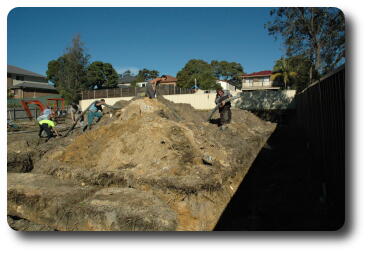 And they even have to climb over the mountain to reach the destination.
That's climb with a hose full of concrete!
And they even have to climb over the mountain to reach the destination.
That's climb with a hose full of concrete!
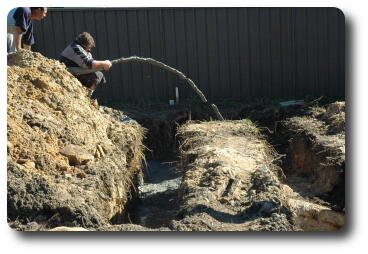 Reached the destination, time to pump more concrete. The excavations
here are up to 1 metre deep. The concrete does not need to fill the
trench, just level it out to give the brick layers something decent
to work from. The plan was to pour the concrete to level things off,
then continue pouring to use up all the concrete, as there was no way
to "send it back", and nowhere to dump it.
Reached the destination, time to pump more concrete. The excavations
here are up to 1 metre deep. The concrete does not need to fill the
trench, just level it out to give the brick layers something decent
to work from. The plan was to pour the concrete to level things off,
then continue pouring to use up all the concrete, as there was no way
to "send it back", and nowhere to dump it.
The concrete deliberately stops in the lower left. It stops on the edge of the original trench for the sewer line which was re-routed along the back fence. So, Chris' plan is to put the sewer lines for my house in that trench, since it very conveniently leads to the man hole on the wester side of the house. And runs almost underneath the bathroom on the eastern side too!
When the last of the concrete was delivered and pumped, it is time to flush the pipe. This is done by forcing a rubber (or more precisely elastic) ball through the hose. As it conforms to the diameter of the pipe, it will force the concrete out, and itself pops out quite energetically, followed by all the comressed air which pushed it along.
Overall, a good days work, and quite a lot done in just a couple of hours.
![]() Building A Home
Building A Home
![]() After The Big Pour I
After The Big Pour I
![]() The Big Pour I
The Big Pour I